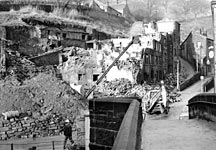|
Home Subscriptions Send us your memories Buy online Links FIRST ISSUE CONTENTS Born During the Plug Drawers' Riot Going, Going . . . Spa Sunday at Cragg Vale . . . |
Buttress Brink
The Rise and Fall of 'Wapping'
Thirty-five years ago a building acknowledged as being of significant architectural and historical importance was razed to the ground in Hebden Bridge. Buttress Brink - also known by the nickname "Wapping" - was deemed unfit for human habitation and in November 1967 the bulldozers moved in. Throughout the 1960s strenuous efforts had been made to save this gloriously eccentric conglomeration of dwellings, all cheek by jowl on the steep hillside above the old packhorse bridge, from which the town derived its name, and linked by a maze of tunnels, corridors, bridges and balconies.  Although even its most ardent supporters could not deny that Buttress Brink fell far short of the housing standards of the day, most townsfolk shared the view that the building - unique in construction and epitomising Hebden Bridge’s famed double-decker houses - was never-the-less worthy of a reprieve, if only as "a museum dedicated to the memory of twentieth century troglodytes," as one wag suggested. Buttress Brink, by the 1960s, was all too typical of a town dismissed by the county planning officer as "dying" and described by another equally pessimistic "expert" as a "builder’s nightmare." Wholesale demolition and redevelopment of virtually the entire town centre seemed the only option; but the problems were immense. Derelict mills, smoke-blackened buildings and a seriously depleted, ageing population were the industrial revolution’s grim legacy to its late twentieth century descendants. The town had the "slightly jaded air of an old curiosity shop" noted a visiting observer, adding that its "sombre stone buildings, many of which are now bulging with age and sprouting ferns, weeds and gas-lamps are not compatible with modern conceptions of what is fit for human habitation." Dragging the town into the modern age was likely to be a "trying process." Most problematical of all was Buttress Brink, where occupants had to walk through a gloomy ground floor tunnel still lit by gas lamps, climb steep steps set into an almost vertical hillside, then cross bridges spanning the gaps between hillside and property. Needless to say the homes within boasted no modern amenities such as bathrooms and toilets; the kitchens, small and cramped, had only a single cold water tap over a stone sink. Adding to the council’s dilemma was the fact that no plans for the property, built just after the Napoleonic Wars, appeared to exist. Who built Buttress Brink and why did a resident prefer it to a prefab? Read the full, fascinating story in Milltown Memories. If this or other stories stirs a memory, we'd be happy to know - send us your memories and comments. |


